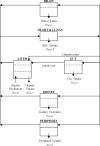The future of open- and closed-loop insulin delivery systems
- PMID: 18088499
- PMCID: PMC3044930
- DOI: 10.1211/jpp.60.1.0001
The future of open- and closed-loop insulin delivery systems
Abstract
We have analysed several aspects of insulin-dependent diabetes mellitus, including the glucose metabolic system, diabetes complications, and previous and ongoing research aimed at controlling glucose in diabetic patients. An expert review of various models and control algorithms developed for the glucose homeostasis system is presented, along with an analysis of research towards the development of a polymeric insulin infusion system. Recommendations for future directions in creating a true closed-loop glucose control system are presented, including the development of multivariable models and control systems to more accurately describe and control the multi-metabolite, multi-hormonal system, as well as in-vivo assessments of implicit closed-loop control systems.
Figures





References
-
- Guyton A, Hall J. Textbook of Medical Physiology. 11. Elsevier Saunders; Philadelphia, PA: 2006.
-
- Larsen PR, Kronenberg HM, Melmed S, Polonsky Kenneth S, editors. Williams Textbook of Endocrinology. 10. Saunders; Philadelphia, PA: 2003.
-
- Greenspan FS, GardnerDavid G, editors. Basic and Clinical Endocrinology. 7. McGraw-Hill; United States: 2004.
-
- LeRoith D, Taylor SI, Olefsky Jerrold M. Diabetes Mellitus: A Fundamental and Clinical Text. 2. Lippincott, Williams, and Wilkins; Philadelphia, PA: 2000.
-
- Puckett WR. PhD Dissertation. Department of Chemical Engineering, The University of Wisconsin-Madision; 1992. Dynamic Modelling of Diabetes Mellitus.
Publication types
MeSH terms
Substances
Grants and funding
LinkOut - more resources
Full Text Sources
Other Literature Sources
Medical

